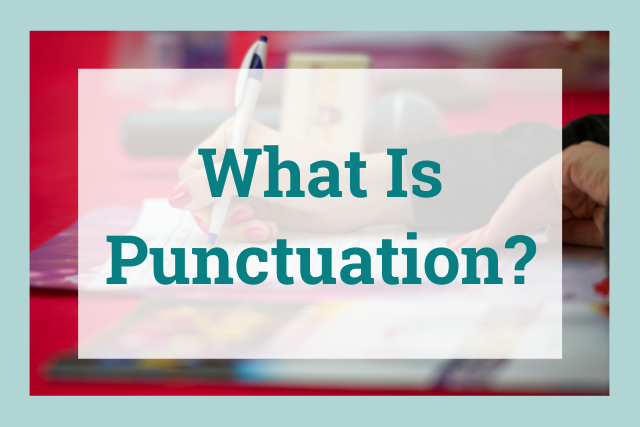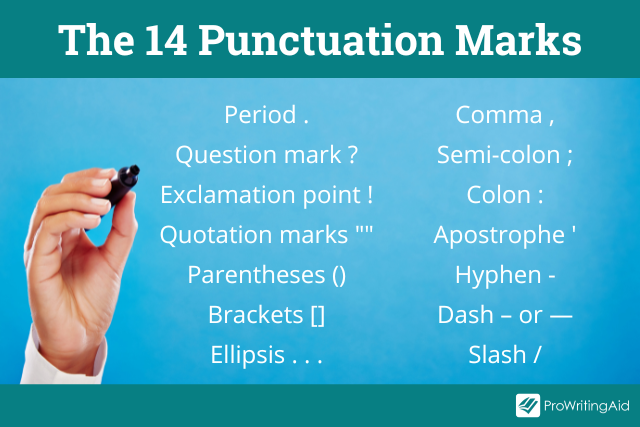
We all learned how to use punctuation marks in school, everything from question marks to quotation marks.
But what is punctuation? Punctuation is a series of symbols and marks that make written language easier to read.
We use punctuation marks to denote pauses, separate elements of sentences, or add emphasis to parts of our writing.
Today, we’re taking a deep dive into what exactly punctuation is, why it’s important, and where it came from.
Where Did Punctuation Come From?
Written language existed long before punctuation. When punctuation marks showed up, they were often used sporadically.
The earliest known example of punctuation comes from the Mesha Stele, also called the Moabite Stone. This 9th century Canaanite stone told the story of the god of Moab. There are dots and lines separating words and sections.
Punctuation only increased slightly over the next few centuries. By about the 5th century BC, the Greeks occasionally used a dot-system punctuation. These were speech marks that told oral performers where to pause.
Later, the Greeks also began to use paragraph marks and an ancient form of quotation marks.
In Asia, the earliest punctuation dates from the 3rd century BC. Some Chinese writing from this era had marks for full stops and ends of chapters.
Punctuation evolved as language, writing, and printing technology changed to give us our modern punctuation marks in English.
The Importance of Punctuation
To fully answer the question “What is punctuation?” we need to understand why it matters.
Punctuation is an important part of English grammar and mechanics because it expresses the elements of speech that aren’t represented by words.
When we speak, we use pauses and asides. We change our intonation and our volume. We use gestures and facial expressions. These are all parts of spoken language, and they can be hard to convey in writing.
That’s where punctuation comes in. We can use an exclamation mark to show strong emotions because we can’t write our intonation and body language.
A question mark tells us that we’re asking a question, not making a statement.
We can express asides with a quotation mark or a bracket. Dashes and hyphens can connect ideas, separate thoughts, and add emphasis when used correctly.
Commas separate items like independent clauses, lists, and introductory phrases. They help our brains slow down to comprehend what we’re reading.
Every punctuation mark has at least one specific purpose in the English language. These form crucial elements of grammar. Punctuation isn’t optional, especially in formal writing.
Of course, sometimes people omit punctuation in informal writing. But this makes it hard to read. Without punctuation, you run the risk of losing your intended meaning, which leads to miscommunication.
What Are the 14 Different Punctuation Marks?
Have you ever wondered how many types of punctuation there are? In English, there are fourteen major punctuation marks.
Let’s check out what these are.
- Period .
- Question mark ?
- Exclamation point !
- Quotation marks “ ”
- Parentheses ( )
- Brackets [ ]
- Ellipsis . . .
- Comma ,
- Semi-colon ;
- Colon :
- Apostrophe ’
- Hyphen -
- Dash – or —
- Slash /

The first three marks (period/full stop, question mark, and exclamation point) are called terminal marks. This means they end sentences.
Parentheses and brackets are pairs and require two parts: an open and a close.
Quotes usually require an open quotation mark and end quotation mark unless the quoted material is longer than one paragraph. Then only the final paragraph will have a closed quotation mark.
There are two types of dashes in English: the en dash and the em dash. These have separate functions, so you might see them listed as separate types of punctuation. The en dash (–) usually shows a connection, while the em dash (—) usually sets information apart.
This isn’t an exhaustive list of punctuation, however. These are the fourteen most common punctuation symbols, but there are others that we sometimes use.
Angle brackets < > are rarely used, but sometimes they denote foreign speech in writing.
We used to use angle brackets to set apart a web address or email address in the early days of the internet, but that is not a common convention anymore. They are still used in computer programming, though.
Another rarely used punctuation mark is the brace: { }. Braces are like brackets, and in writing, they are used to express a list of equal choices. This isn’t common. It’s more common to see them in mathematics or musical notations.
The backslash \ isn’t a true English punctuation mark. It’s used in computer programming languages, but it has no uses in formal or informal English writing.
Some people recognize the interrobang ‽ as a punctuation mark. This is a combination of the exclamation mark and the question mark. But you can achieve the same meaning by writing: ?!
The paragraph symbol ¶ was once widely used, but most people don’t recognize it as a punctuation mark anymore.
As you can see, there are many punctuation marks in English, and their usage continues to change over time.
Conclusion: What Is Punctuation?
With so many punctuation marks, it’s easy to get confused about how to use them. You can use ProWritingAid’s punctuation checker to ensure you’re using punctuation correctly in your writing.

The symbols we use to mark pauses, tone, and more are a vital part of good writing. Punctuation has a long history, and it continues to evolve as our language changes.


